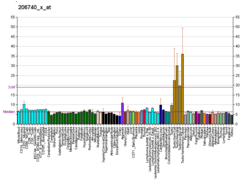SYCP1
Synaptonemal complex protein 1 is a protein that in humans is encoded by the SYCP1 gene.[5][6]
References
- 1 2 3 GRCh38: Ensembl release 89: ENSG00000198765 - Ensembl, May 2017
- 1 2 3 GRCm38: Ensembl release 89: ENSMUSG00000027855 - Ensembl, May 2017
- ↑ "Human PubMed Reference:".
- ↑ "Mouse PubMed Reference:".
- ↑ Tureci O, Sahin U, Zwick C, Koslowski M, Seitz G, Pfreundschuh M (Jun 1998). "Identification of a meiosis-specific protein as a member of the class of cancer/testis antigens". Proc Natl Acad Sci U S A. 95 (9): 5211–6. doi:10.1073/pnas.95.9.5211. PMC 20240. PMID 9560255.
- ↑ "Entrez Gene: SYCP1 synaptonemal complex protein 1".
Further reading
- Neumann F, Wagner C, Preuss KD, et al. (2005). "Identification of an epitope derived from the cancer testis antigen HOM-TES-14/SCP1 and presented by dendritic cells to circulating CD4+ T cells". Blood. 106 (9): 3105–13. doi:10.1182/blood-2005-04-1487. PMID 16030183.
- Costa Y, Speed R, Ollinger R, et al. (2005). "Two novel proteins recruited by synaptonemal complex protein 1 (SYCP1) are at the centre of meiosis". J. Cell Sci. 118 (Pt 12): 2755–62. doi:10.1242/jcs.02402. PMID 15944401.
- Strausberg RL, Feingold EA, Grouse LH, et al. (2003). "Generation and initial analysis of more than 15,000 full-length human and mouse cDNA sequences". Proc. Natl. Acad. Sci. U.S.A. 99 (26): 16899–903. doi:10.1073/pnas.242603899. PMC 139241. PMID 12477932.
- Eichmuller S, Usener D, Dummer R, et al. (2001). "Serological detection of cutaneous T-cell lymphoma-associated antigens". Proc. Natl. Acad. Sci. U.S.A. 98 (2): 629–34. doi:10.1073/pnas.021386498. PMC 14639. PMID 11149944.
- Kondoh N, Nishina Y, Tsuchida J, et al. (1997). "Assignment of synaptonemal complex protein 1 (SCP1) to human chromosome 1p13 by fluorescence in situ hybridization and its expression in the testis". Cytogenet. Cell Genet. 78 (2): 103–4. doi:10.1159/000134637. PMID 9371398.
- Meuwissen RL, Meerts I, Hoovers JM, et al. (1997). "Human synaptonemal complex protein 1 (SCP1): isolation and characterization of the cDNA and chromosomal localization of the gene". Genomics. 39 (3): 377–84. doi:10.1006/geno.1996.4373. PMID 9119375.
- Meuwissen RL, Offenberg HH, Dietrich AJ, et al. (1993). "A coiled-coil related protein specific for synapsed regions of meiotic prophase chromosomes". EMBO J. 11 (13): 5091–100. PMC 556987. PMID 1464329.
This article is issued from
Wikipedia.
The text is licensed under Creative Commons - Attribution - Sharealike.
Additional terms may apply for the media files.





